Effect of Cd on Mechanical Properties of Al-Si-Cu-Mg Alloys under Different Multi-Stage Solution Heat Treatment
Abstract
:1. Introduction
2. Experimental Procedure
3. Results
3.1. Microstructure
3.2. Aging Hardness
3.3. Tensile Properties and Fracture Analysis
4. Discussion
4.1. Equilibrium Phase Diagram Analysis
4.2. Low-Melting Cd Phase
5. Conclusions
- YS and UTS of Cd-containing alloys are stronger than Cd-free alloys, but the elongation is lower than the Cd-free alloys.
- The addition of Cd promotes the precipitation of the θ″ phase in the Al-Si-Cu-Mg alloy and improves the mechanical properties of the alloy.
- For the Cd-free alloys, a long solution time is conducive to the full diffusion and homogenization of copper elements, thereby improving the precipitation-strengthening ability of the alloy. For the Cd-containing alloys, the Cd element is enriched in the Si-Al phase boundary, which reduces the precipitation-strengthening ability of Cd, resulting in the alloys’ mechanical properties after a three-stage heat treatment being lower than that of a two-stage heat treatment.
Author Contributions
Funding
Institutional Review Board Statement
Informed Consent Statement
Data Availability Statement
Conflicts of Interest
References
- SjöLander, E.; Seifeddine, S. The heat treatment of Al-Si-Cu-Mg casting alloys. J. Mater. Process. Technol. 2010, 210, 1249–1259. [Google Scholar] [CrossRef] [Green Version]
- Samuel, F.H. Incipient melting of Al5Mg8Si6Cu2 and Al2Cu intermetallics in unmodified and strontium-modified Al-Si-Cu-Mg (319) alloys during solution heat treatment. J. Mater. Sci. 1998, 33, 2283–2297. [Google Scholar] [CrossRef]
- Toda, H.; Nishimura, T.; Uesugi, K.; Suzuki, Y.; Kobayashi, M. Influence of high-temperature solution treatments on mechanical properties of an Al-Si-Cu aluminum alloy. Acta Mater. 2010, 58, 2014–2025. [Google Scholar] [CrossRef]
- Aguilera Luna, I.; Mancha Molinar, H.; Castro Román, M.J.; Escobedo Bocardo, J.C.; Herrera Trejo, M. Improvement of the tensile properties of an Al-Si-Cu-Mg aluminum industrial alloy by using multi stage solution heat treatments. Mater. Sci. Eng. A 2013, 561, 1–6. [Google Scholar] [CrossRef]
- Ma, Z.; Samuel, E.; Mohamed, A.; Samuel, A.M.; Samuel, F.H.; Doty, H.W. Influence of aging treatments and alloying additives on the hardness of Al-11Si-2.5Cu-Mg alloys. Mater. Des. 2010, 31, 3791–3803. [Google Scholar] [CrossRef]
- Amerioon, A.; Emamy, M.; Ashuri, G. Investigation the Effect of Al-5Ti-1B Grain Refiner and T6 Heat Treatment on Tensile Properties of Al-8%Mg. Procedia Mater. Sci. 2015, 11, 32–37. [Google Scholar] [CrossRef] [Green Version]
- Hardy, H.K. The ageing characteristics of ternary aluminium-copper alloys with cadmium indium or tin. J. Inst. Met. 1952, 80, 483–492. [Google Scholar]
- Raynor, G.V.; Lee, J.A. The tin-rich intermediate phases in the alloys of tin with cadmium, indium and mercury. Acta Mater. 1954, 2, 616–620. [Google Scholar] [CrossRef]
- Runxia, L.I.; Rongde, L.I.; Guan, H. Effect of Cd addition on the aging process of Al-Si-Cu-Mg cast alloy. Acta Mater. 2004, 40, 867–872. [Google Scholar]
- Sofyan, B.T.; Raviprasad, K.; Ringer, S.P. Effects of microalloying with Cd and Ag on the precipitation process of Al-4Cu-0.3Mg (wt%) alloy at 200 °C. Micron 2001, 32, 851–856. [Google Scholar] [CrossRef]
- Lu, G.; Sun, B.; Wang, J.; Liu, Y.; Liu, C. Enhanced high-temperature age-hardening behavior and mechanical properties of Al–Mg–Si alloys via microalloying with Cd. Mater. Sci. Eng. A 2021, 825, 141910. [Google Scholar] [CrossRef]
- Feng, Q.; Jin, S.; Gang, S.; Li, Y. Enhanced dispersoid precipitation and dispersion strengthening in an Al alloy by microalloying with Cd. Acta Mater. 2018, 157, 114–125. [Google Scholar]
- Gogoi, S.; Banerjee, S.; Kirtania, S.; Kashyap, S.; Bhadra, R. Computational modelling of tensile flow parameters for 2219Al alloys microalloyed with Cd. Int. J. Interact. Des. M 2022, 1–10. [Google Scholar] [CrossRef]
- Bourgeois, L.; Nie, J.F.; Muddle, B.C. Assisted nucleation of θ′ phase in Al–Cu–Sn: The modified crystallography of tin precipitates. Philos. Mag. 2005, 85, 3487–3509. [Google Scholar] [CrossRef]
- Ringer, S.P.; Hono, K.; Sakurai, T. The effect of trace additions of Sn on precipitation in Al-Cu alloys: An atom probe field ion microscopy study. Metall. Mater. Trans. A 1995, 26, 2207–2217. [Google Scholar] [CrossRef]
- Homma, T.; Moody, M.P.; Saxey, D.W.; Ringer, S.P. Effect of Sn Addition in Preprecipitation Stage in Al-Cu Alloys: A Correlative Transmission Electron Microscopy and Atom Probe Tomography Study. Metall. Mater. Trans. A 2012, 43, 2192–2202. [Google Scholar] [CrossRef]
- Marioara, C.D.; Andersen, S.J.; Stene, T.N.; Hasting, H.; Walmsley, J.; Helvoort, A.T.J.V.; Holmestad, R. The effect of Cu on precipitation in Al-Mg-Si alloys. Philos. Mag. 2007, 87, 3385–3413. [Google Scholar] [CrossRef]
- Zandbergen, M.W.; Xu, Q.; Cerezo, A.; Smith, G. Study of precipitation in Al-Mg-Si alloys by Atom Probe Tomography I. Microstructural changes as a function of ageing temperature. Acta Mater. 2015, 101, 136–148. [Google Scholar] [CrossRef]
- Kim, J.H.; Marioara, C.D.; Holmestad, R.; Kobayashi, E.; Sato, T. Effects of Cu and Ag additions on age-hardening behavior during multi-step aging in Al-Mg-Si alloys. Mater. Sci. Eng. A 2013, 560, 154–162. [Google Scholar] [CrossRef]
- MøRtsell, E.A.; Marioara, C.D.; Andersen, S.J.; RøYset, J.; Reiso, O.; Holmestad, R. Effects of Germanium, Copper, and Silver Substitutions on Hardness and Microstructure in Lean Al-Mg-Si Alloys. Metall. Mater. Trans. A 2015, 46, 4369–4379. [Google Scholar] [CrossRef] [Green Version]
- Wiengmoon, A.; Pearce, J.; Chairuangsri, T.; Isoda, S.; Kurata, H. HRTEM and HAADF-STEM of precipitates at peak ageing of cast A319 aluminium alloy. Micron 2013, 45, 32–36. [Google Scholar] [CrossRef] [PubMed]
- Bourgeois, L.; Dwyer, C.; Weyland, M.; Nie, J.F.; Muddle, B.C. The magic thicknesses of θ′ precipitates in Sn-microalloyed Al-Cu. Acta Mater. 2016, 60, 633–644. [Google Scholar] [CrossRef]
- Silcock, J.M.; Heal, T.J.; Hardy, H.K. Structural ageing characteristics of binary aluminium-copper alloys. J. Inst. Met. 1954, 2, 885–887. [Google Scholar]
- Biswas, A.; Siegel, D.J.; Wolverton, C.; Seidman, D.N. Precipitates in Al-Cu alloys revisited: Atom-probe tomographic experiments and first-principles calculations of compositional evolution and interfacial segregation. Acta Mater. 2011, 59, 6187–6204. [Google Scholar] [CrossRef]
- Costa, T.A.; Dias, M.; Gomes, L.G.; Rocha, O.L.; Garcia, A. Effect of solution time in T6 heat treatment on microstructure and hardness of a directionally solidified Al-Si-Cu alloy. J. Alloys Compd. 2016, 683, 485–494. [Google Scholar] [CrossRef]
- El-Menshawy, K.; El-Sayed, A.; El-Bedawy, M.E.; Ahmed, H.A.; El-Raghy, S.M. Effect of aging time at low aging temperatures on the corrosion of aluminum alloy 6061. Corros. Sci. 2012, 54, 167–173. [Google Scholar] [CrossRef]
- Ceschini, L.; Morri, A.; Morri, A.; Toschi, S.; Johansson, S.; Seifeddine, S. Effect of microstructure and overaging on the tensile behavior at room and elevated temperature of C355-T6 cast aluminum alloy. Mater. Des. 2015, 83, 626–634. [Google Scholar] [CrossRef]
- Chen, K.; Liu, H.; Zhuo, Z.; Song, L.; Todd, R.I. The improvement of constituent dissolution and mechanical properties of 7055 aluminum alloy by stepped heat treatments. J. Mater. Process. Technol. 2003, 142, 190–196. [Google Scholar] [CrossRef]
- Luo, Y.; Xiaojing, X.U.; Zhang, Y.; Zhang, Z. Effect of Enhanced-solid-solution on Intergranular Corrosion and Exfoliation Corrosion of 7075 Al Alloy. Hot Work. Technol. 2012, 6, 288–293. [Google Scholar]
- Chen, X.; Song, R.; Li, J. Current Research Status and Development Trends of 7xxx Series Aluminum Alloys. Mater. Rev. 2009, 19, 1651–1662. [Google Scholar]
- Sokolowski, J.H.; Sun, X.C.; Byczynski, G.; Northwood, D.O.; Esseltine, A. The removal of copper-phase segregation and the subsequent improvement in mechanical properties of cast 319 aluminium alloys by a two-stage solution heat treatment. J. Mater. Process. Technol. 1995, 53, 385–392. [Google Scholar] [CrossRef]
- Han, Y.; Samuel, A.M.; Doty, H.W.; Valtierra, S.; Samuel, F.H. Optimizing the tensile properties of Al-Si-Cu-Mg 319-type alloys: Role of solution heat treatment. Mater. Des. 2014, 58, 426–438. [Google Scholar] [CrossRef]
- Mohamed, A.M.A.; Samuel, F.H.; Al Kahtani, S. Influence of Mg and solution heat treatment on the occurrence of incipient melting in Al-Si-Cu-Mg cast alloys. Mater. Sci. Eng. A 2012, 543, 22–34. [Google Scholar] [CrossRef]
- Kang, H.G.; Kida, M.; Miyahara, H.; Ogi, K. Age-hardening characteristics of Al-Si-Cu-base cast alloys. J. Jpn. Foundry Eng. Soc. 1999, 107, 507–515. [Google Scholar]
- Li, R.; Chen, Y.; Yuan, X.; Yingdong, Q.; Rongde, L. Effects of Cd and Sn on double-peak age-hardening behaviors of Al-Si-Cu-Mg cast alloys. China Foundry 2010, 7, 1–5. [Google Scholar]
- Xiao, Q.; Liu, H.; Yi, D.; Yin, D.; Chen, Y.; Zhang, Y.; Wang, B. Effect of Cu content on precipitation and age-hardening behavior in Al-Mg-Si-xCu alloys. J. Alloys Compd. 2016, 695, 1005–1013. [Google Scholar] [CrossRef]
- Cai, Q.; Mendis, C.L.; Wang, S.; Chang, I.; Fan, Z. Effect of heat treatment on microstructure and tensile properties of die-cast Al-Cu-Si-Mg alloys. J. Alloys Compd. 2021, 881, 160559. [Google Scholar]
- Wang, D.; Liu, S.; Zhang, X.; Li, X.; Nagaumi, H. Fast aging strengthening by hybrid precipitates in high pressure die-cast Al-Si-Cu-Mg-Zn alloy. Mater. Charact. 2021, 179, 111312. [Google Scholar] [CrossRef]
- Zuo, L.; Ye, B.; Feng, J.; Kong, X.; Jiang, H. Effect of Q-Al5Cu2Mg8Si6 phase on mechanical properties of Al-Si-Cu-Mg alloy at elevated temperature. Mater. Sci. Eng. A 2017, 693, 26–32. [Google Scholar] [CrossRef]
- Alexander, W.B.; Slifkin, L.M. Diffusion of Solutes in Aluminum and Dilute Aluminum Alloys. Phys. Rev. B 1970, 1, 3274–3282. [Google Scholar] [CrossRef]
- Du, Y.; Chang, Y.A.; Huang, B. Diffusion coefficients of some solutes in fcc and liquid Al: Critical evaluation and correlation. Mater. Sci. Eng. A 2003, 363, 140–151. [Google Scholar] [CrossRef]
- Simonovic, D.; Sluiter, M.H.F. Impurity diffusion activation energies in Al from first principles. Phys. Rev. B Condens. Matter 2009, 79, 263–274. [Google Scholar] [CrossRef] [Green Version]
- Porter, D.A.; Easterling, K.E.; Sherif, M. Phase Transformations in Metals and Alloys (Revised Reprint); CRC Press: Boca Raton, FL, USA, 2009; ISBN 1439883572. [Google Scholar]

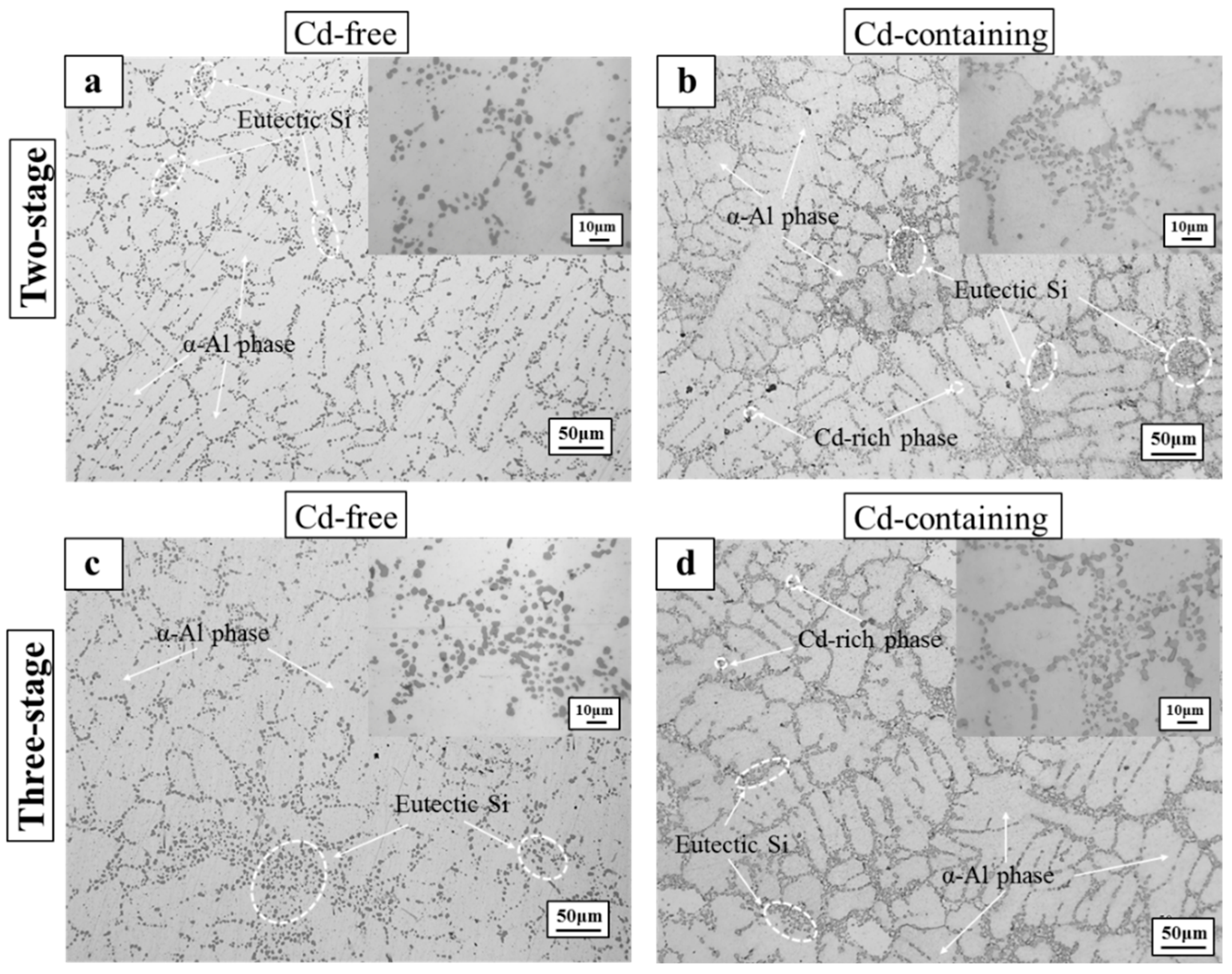


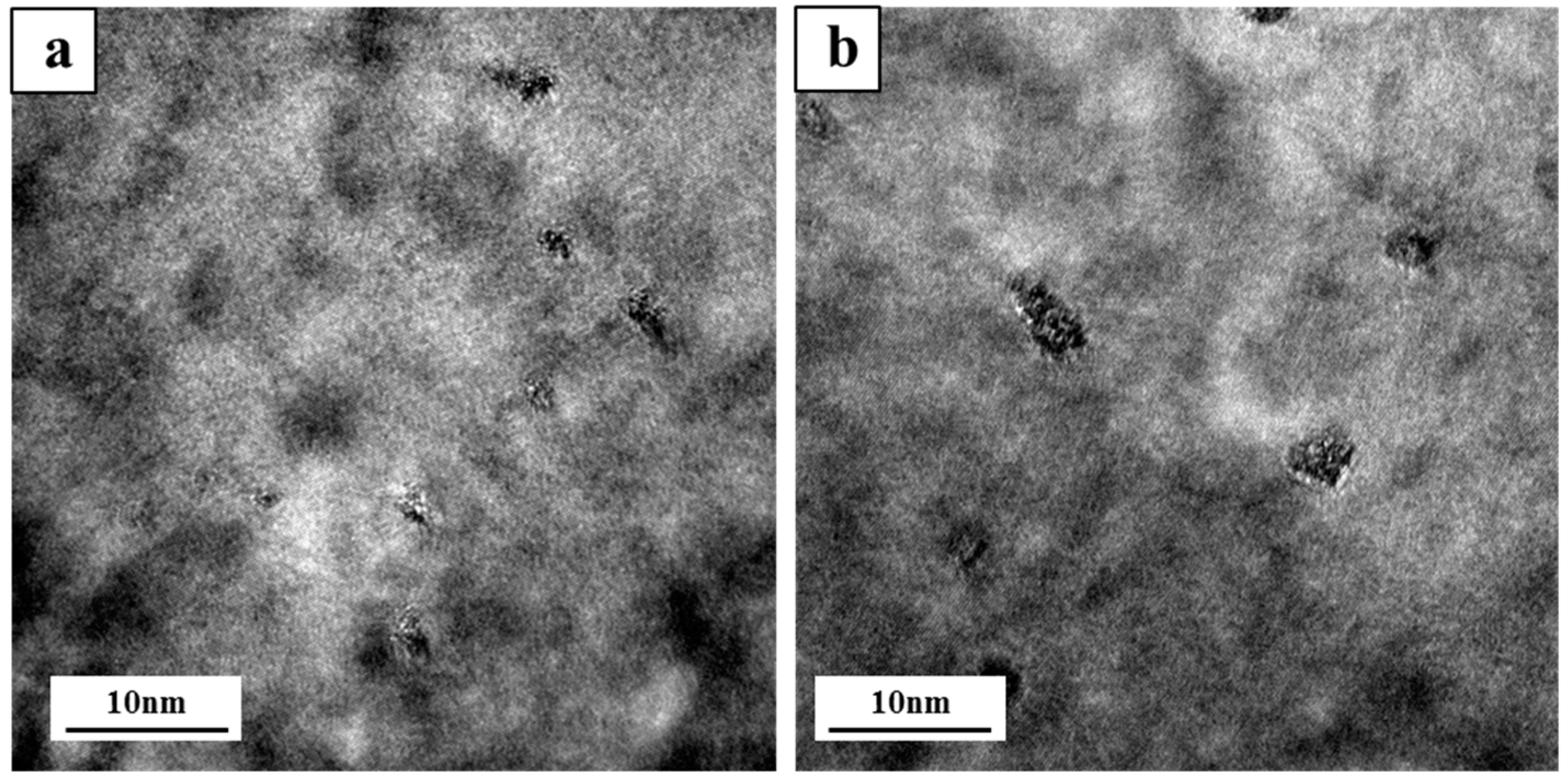
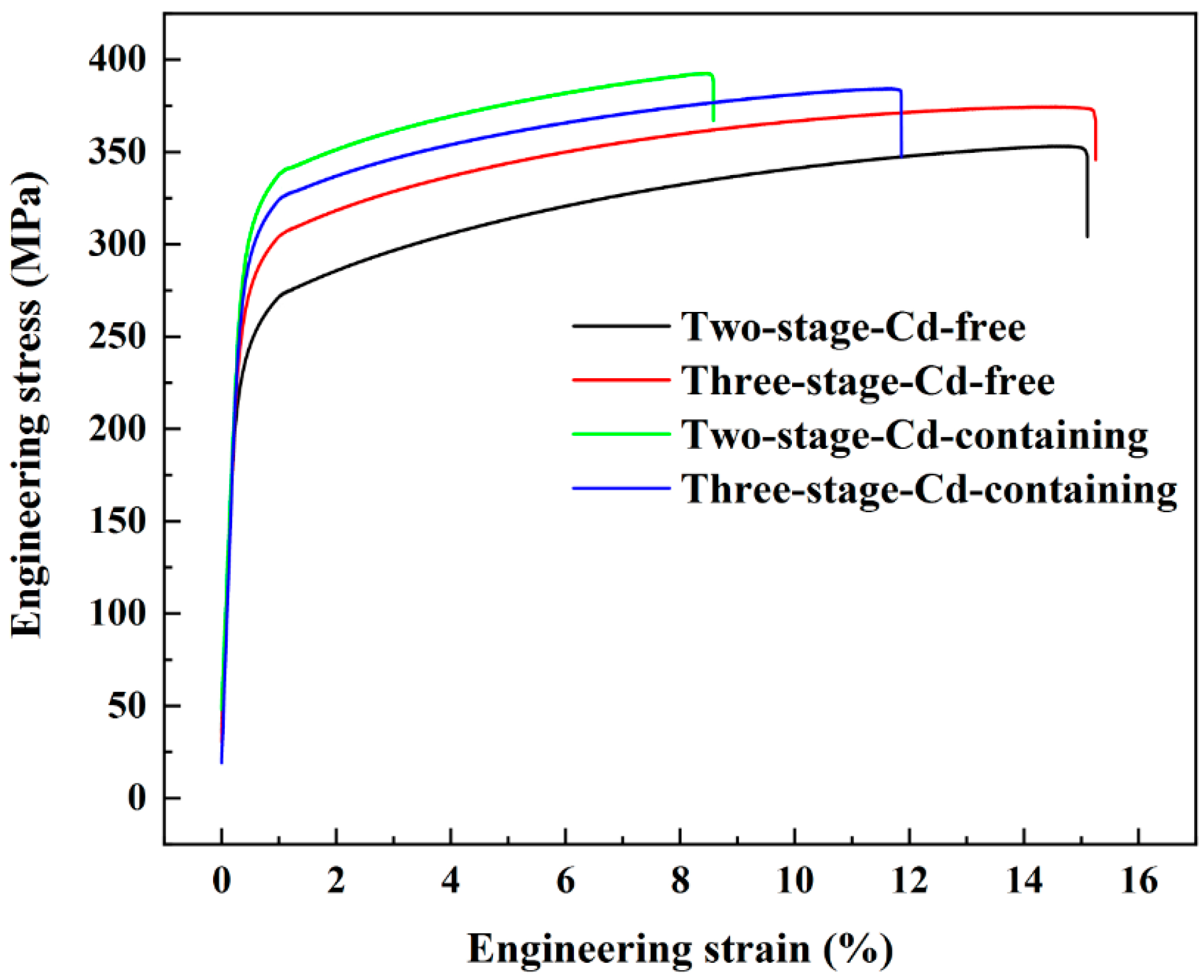


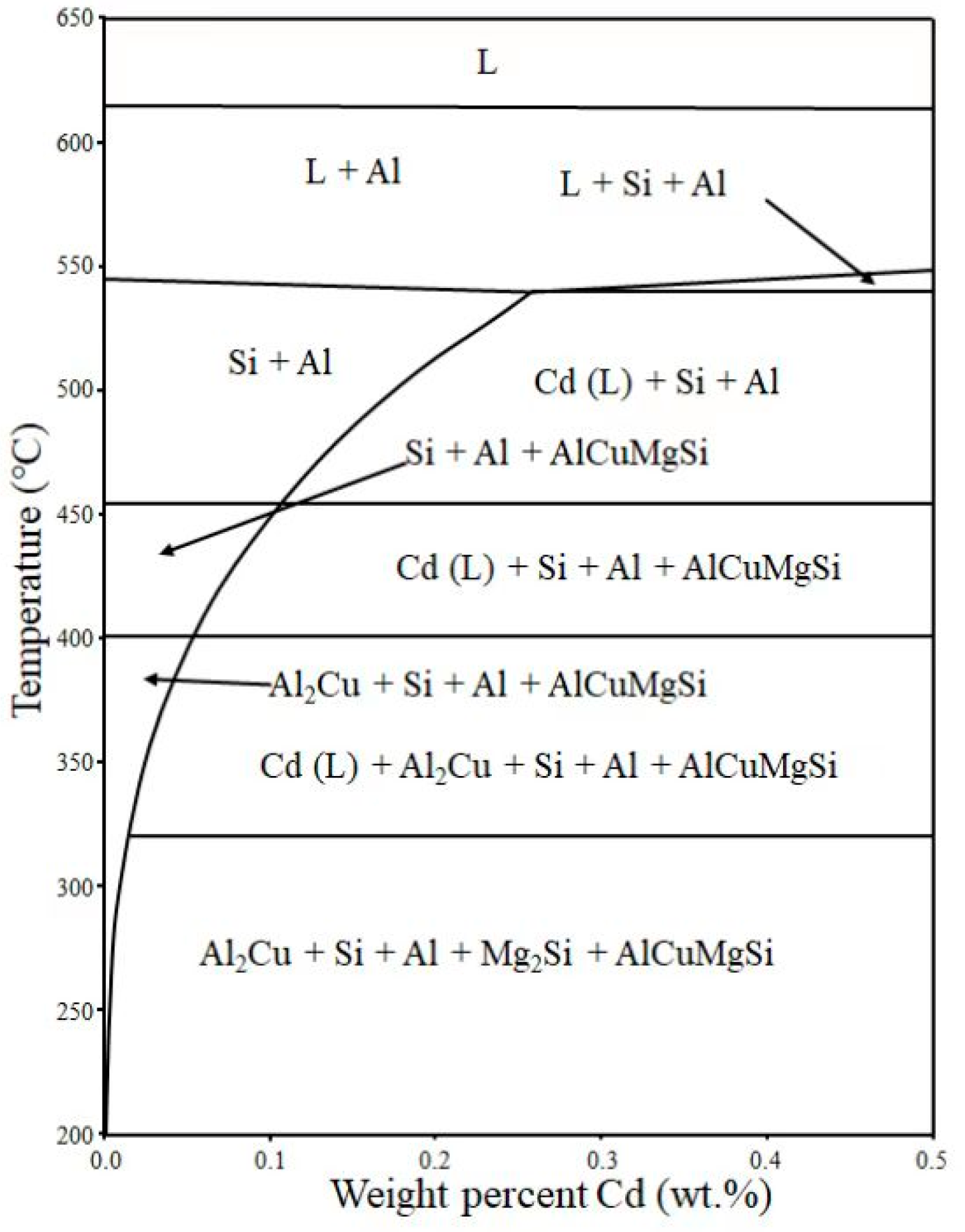
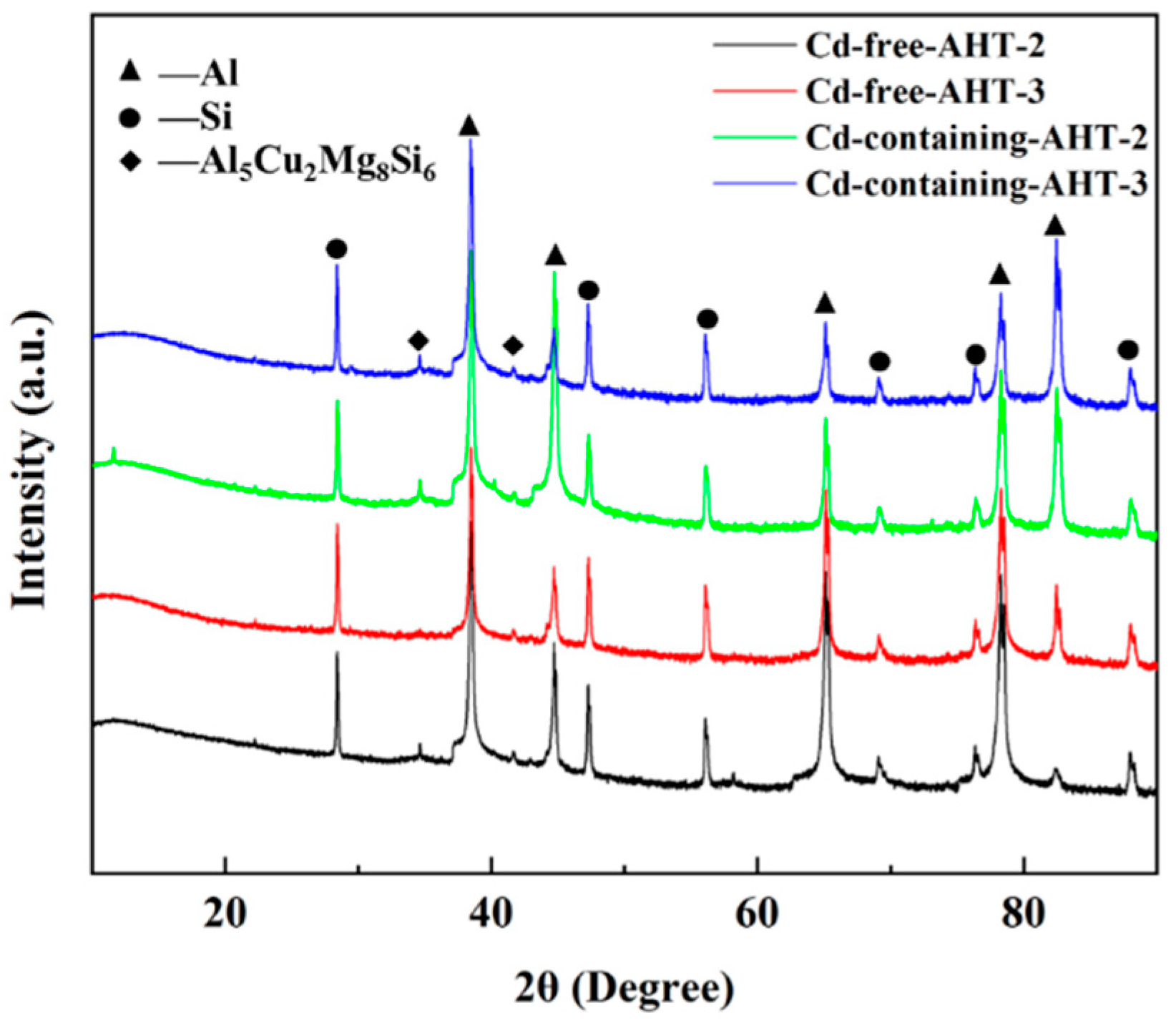
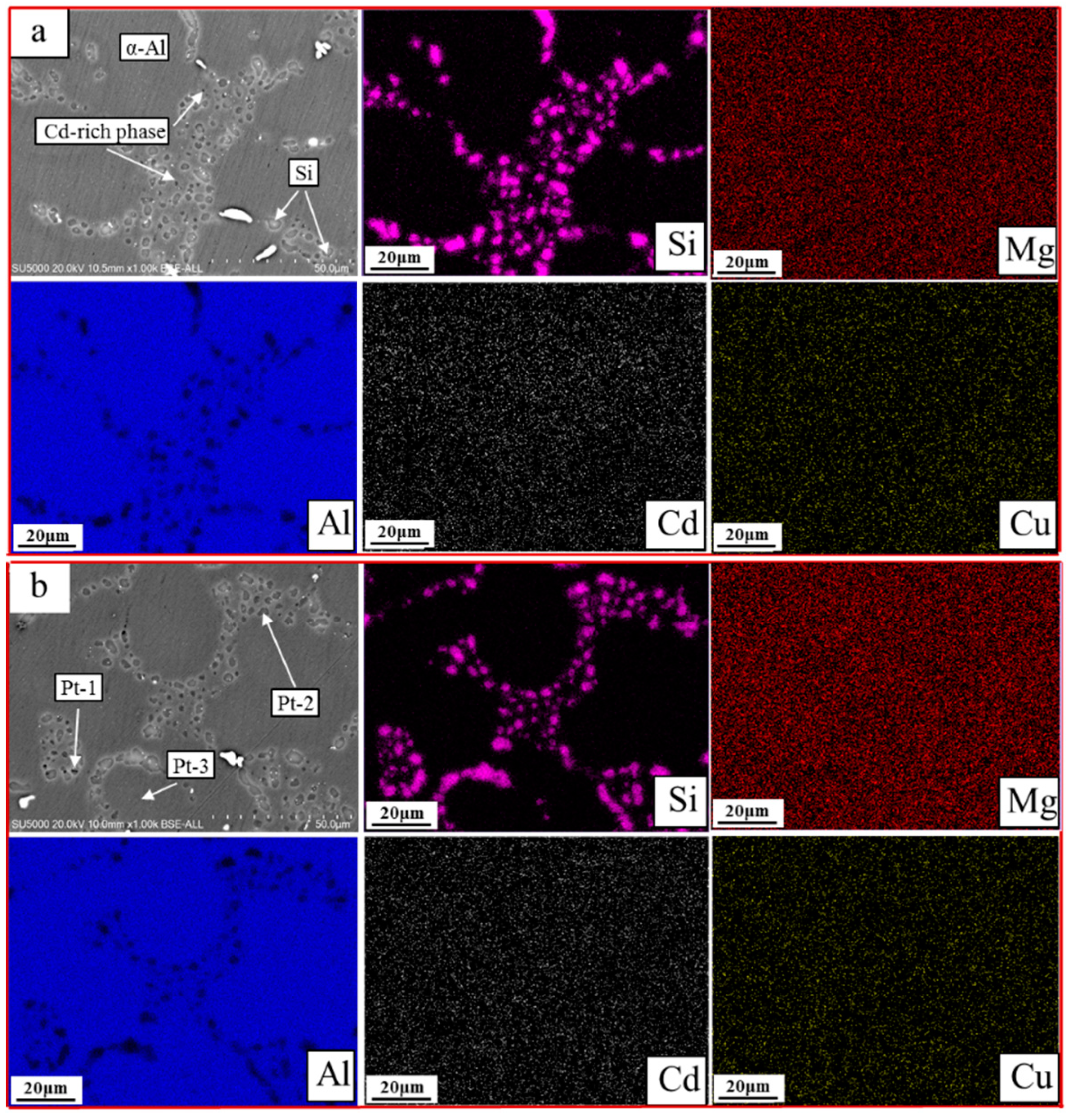

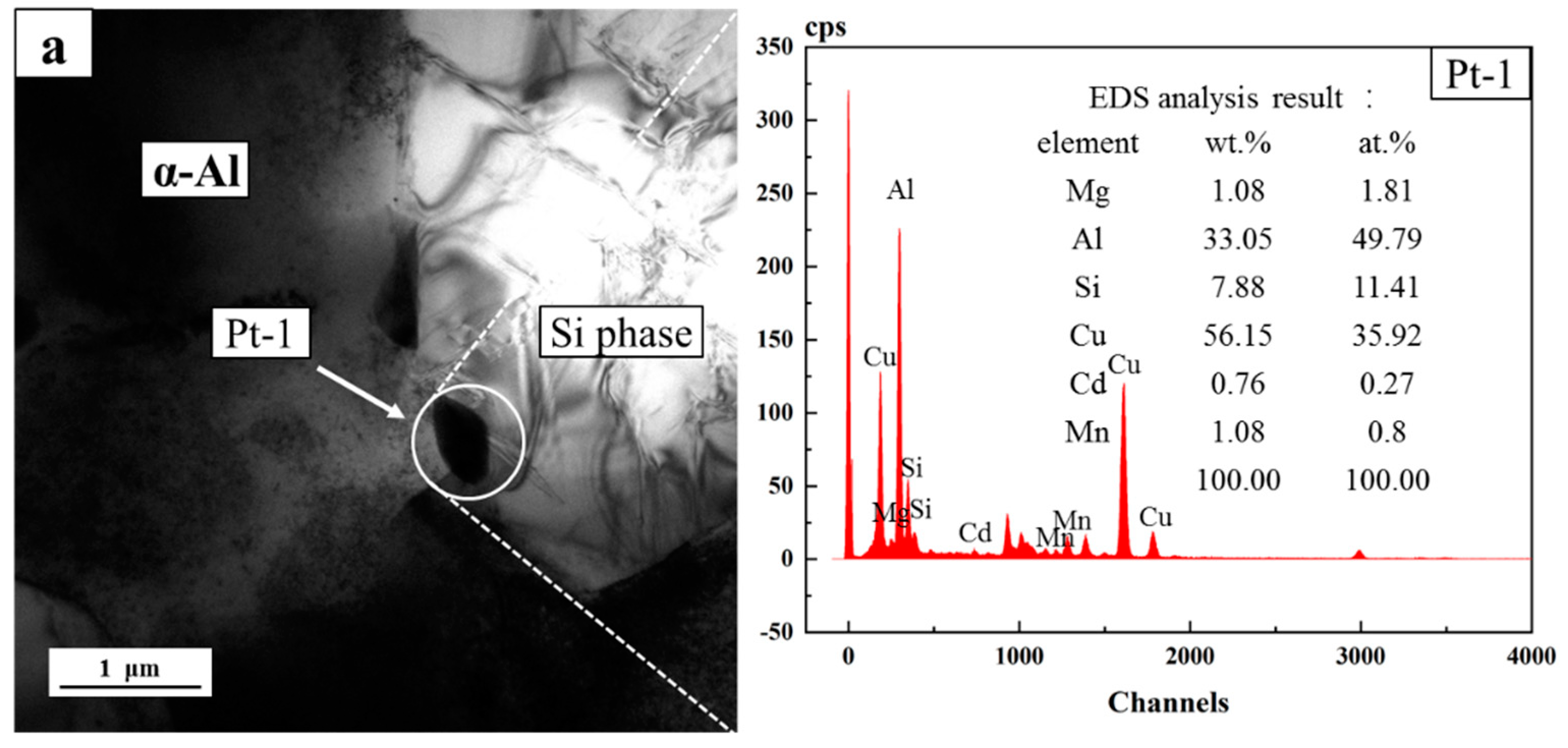
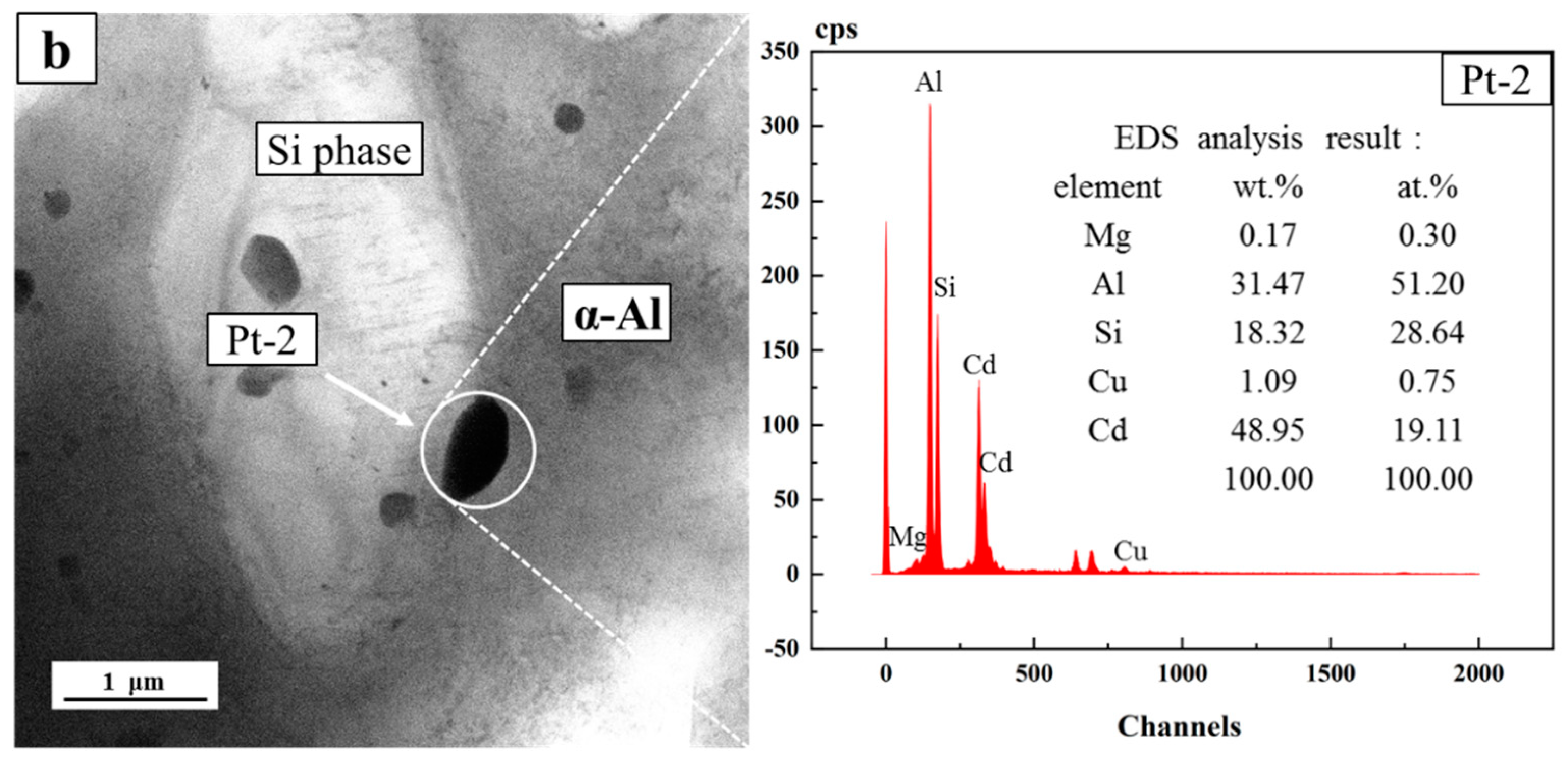

| Alloy | Si | Cu | Mg | Mn | Ti | Fe | Sr | Cd | Al |
|---|---|---|---|---|---|---|---|---|---|
| Cd-free | 7.52 | 1.63 | 0.25 | 0.25 | 0.18 | 0.05 | 0.06 | - | Balance |
| Cd-containing | 7.28 | 1.57 | 0.28 | 0.23 | 0.19 | 0.05 | 0.06 | 0.29 | Balance |
| Process of Treatment | Solid Solution Stages | Aging Stage | ||||||
|---|---|---|---|---|---|---|---|---|
| Stage 1 | Stage 2 | Stage 3 | ||||||
| T, (°C) | t, (h) | T, (°C) | t, (h) | T, (°C) | t, (h) | T, (°C) | t, (h) | |
| AHT-2 | 500 | 4 | 520 | 4 | - | - | 175 | - |
| AHT-3 | 490 | 4 | 500 | 6 | 520 | 8 | ||
| Alloys | YS (MPa) | UTS (MPa) | El (%) |
|---|---|---|---|
| two-stage-Cd-free | 240 ± 3 | 353 ± 9 | 11 ± 3 |
| three-stage-Cd-free | 279 ± 6 | 373 ± 7 | 10 ± 2 |
| two-stage-Cd-containing | 308 ± 5 | 390 ± 7 | 7 ± 2 |
| three-stage-Cd-containing | 295 ± 4 | 384 ± 4 | 10 ± 1 |
Publisher’s Note: MDPI stays neutral with regard to jurisdictional claims in published maps and institutional affiliations. |
© 2022 by the authors. Licensee MDPI, Basel, Switzerland. This article is an open access article distributed under the terms and conditions of the Creative Commons Attribution (CC BY) license (https://creativecommons.org/licenses/by/4.0/).
Share and Cite
Mao, H.; Bai, X.; Song, F.; Song, Y.; Jia, Z.; Xu, H.; Wang, Y. Effect of Cd on Mechanical Properties of Al-Si-Cu-Mg Alloys under Different Multi-Stage Solution Heat Treatment. Materials 2022, 15, 5101. https://doi.org/10.3390/ma15155101
Mao H, Bai X, Song F, Song Y, Jia Z, Xu H, Wang Y. Effect of Cd on Mechanical Properties of Al-Si-Cu-Mg Alloys under Different Multi-Stage Solution Heat Treatment. Materials. 2022; 15(15):5101. https://doi.org/10.3390/ma15155101
Chicago/Turabian StyleMao, Hongkui, Xiaoyu Bai, Feng Song, Yuewen Song, Zhe Jia, Hong Xu, and Yu Wang. 2022. "Effect of Cd on Mechanical Properties of Al-Si-Cu-Mg Alloys under Different Multi-Stage Solution Heat Treatment" Materials 15, no. 15: 5101. https://doi.org/10.3390/ma15155101






